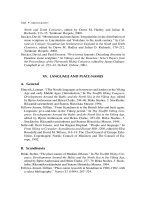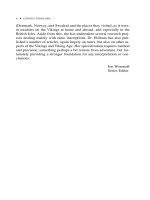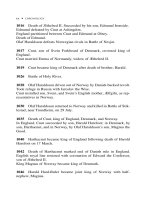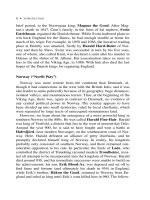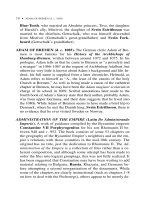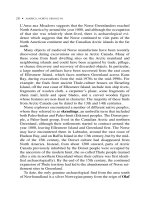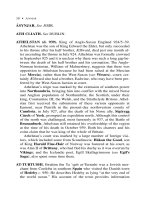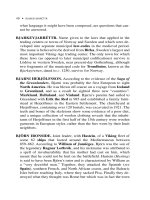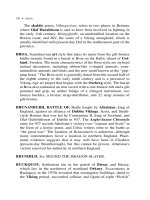The A to Z of the Vikings 34 ppsx
Bạn đang xem bản rút gọn của tài liệu. Xem và tải ngay bản đầy đủ của tài liệu tại đây (64.49 KB, 10 trang )
and Scandinavia in the Early Viking Age, which contain introductory sur-
veys alongside more detailed and discursive articles on individual aspects
of the Viking experience in these regions. No survey of the British Isles
has been published since Henry Loyn’s The Vikings in Britain, so for
more up-to-date accounts incorporating recent archaeological evidence in
particular, readers are instead referred to surveys of the individual coun-
tries: James Graham-Campbell and Colleen Batey’s Vikings in Scotland:
An Archaeological Survey, Mark Redknap’s Vikings in Wales: An Ar-
chaeological Quest, and Julian Richards’s Viking Age England. Barbara
Crawford’s Scandinavian Scotland is a key work for students of the
Vikings in Scotland and is particularly useful because it deals with writ-
ten and place-name evidence, as well as archaeological material. Gillian
Fellows-Jensen’s work on the place-names of the British Isles is an es-
sential starting point for anyone interested in onomastics and in the den-
sity of Scandinavian settlement in the British Isles, although it should be
noted that her views have developed and changed over the period since
she began publishing.
In addition to the items listed in section VII, readers of French are
also directed to Lucien Musset’s Les Invasions: Le second assaut con-
tre l’Europe chrétienne (VIIe–XIe siècles). Published in 1971 (Paris:
Presses universitaires de France), this remains a classic work on the Eu-
ropean experience during the Viking Age. The recently-published col-
lection of papers, L’héritage maritime des Vikings en Europe de l’Ouest
(Caen: Presses universitaires de Caen, 2002), edited by Elisabeth Ridel
contains several articles on the Vikings in Normandy, including work on
ships and the maritime vocabulary of the region. Most articles also have
short English summaries for those who do not read French.
Recent years have seen fresh archaeological work on Scandinavian
activity in Eastern Europe, which has led to a reassessment of the na-
ture and role of the Rus in the mixed society of European Russia. Simon
Franklin and Jonathan Shephard’s The Emergence of the Rus is a recent
and authoritative account of the Scandinavian contribution.
Those seeking a general introduction to the range of Viking ships and
navigation techniques are directed to the articles by Jan Bill and Arne Emil
Christensen in section IX. Olaf Olsen and Ole Crumlin-Pedersen’s Five
Viking Ships from Roskilde Fjord provides a good introduction to these im-
portant finds. Judith Jesch’s book is a critical account of the vocabulary
used in skaldic poetry and runic inscriptions to describe Viking ships and
308 • BIBLIOGRAPHY
their crews. Seán McGrail’s Ancient Boats is a technical and comparative
account of the ships of northwest Europe and is recommended for those
who require a more in-depth and contextual view of Viking ships and ship-
building. Ian Heath and Angus McBride’s The Vikings is part of a popular
series on the “history, organization, appearance, and equipment of famous
fighting men of the past and present” and contains color illustrations of
how Viking warriors and weapons may have looked, as well as plates
showing some of the more famous archaeological finds of weapons and ar-
mor. There is a small bibliography at the end of this book, but this is very
general and somewhat outdated; those seeking more detail and more ref-
erences are advised to consult the entries “Weapons” and “Warfare” in Me-
dieval Scandinavia: An Encyclopedia (see section I).
Much of the evidence for Scandinavian society postdates the Viking
Age and comes from Iceland, rather than Denmark, Norway, or Swe-
den. Saga and Society, the English translation of Preben Meulengracht
Sørensen’s 1977 Danish classic Saga og Samfund, provides an excellent
introduction into the literary evidence for Icelandic society in the me-
dieval period. However, runic inscriptions and skaldic poetry provide
some information about conditions in Scandinavia before c. AD 1100.
Judith Jesch’s books on Viking women and men deal with both types of
this evidence, as well as other kinds. However, while Women in the
Viking Age is written as an introduction that can be read by both the be-
ginner and the more experienced researcher, Ships and Men in the Late
Viking Age is more detailed and more technical in its discussion and fo-
cuses on the precise meaning of social ranks that are referred to in in-
scriptions and poetry. Ruth Mazo Karras’s book on slavery remains the
classic work on this subject.
Helen Clarke and Björn Ambrosiani’s Towns in the Viking Age con-
tains accounts of individual towns across northern Europe, as well as
more general information about the development of urban communities
in this period, and remains the best starting point for layman and scholar
alike. Viking-Age Coinage in Northern Lands includes an introductory
article by A. E. Lieber on “International trade and coinage in the north-
ern lands during the early Middle Ages” (pp. 1–34). Readers of the
Scandinavian languages are also encouraged to consult the entries
“Coins and mints” and “Hoards” in Medieval Scandinavia: An Ency-
clopedia (see section I), which includes a comprehensive bibliography
of works, many of which are written in Danish, Norwegian, or Swedish.
BIBLIOGRAPHY • 309
Those seeking a good introduction to Norse mythology could start with
R. I. Page’s Norse Myths, a slim volume that nevertheless manages to sur-
vey all the major sources, tales, and provides a useful annotated select
bibliography. More detail about scholarship on the subject can be found
in John Lindow’s “Mythology and mythography.” Anthony Faulkes’s
translation of Snorri Sturluson’s Prose Edda (see section II) is essential
for those who wish to consult one of the two major primary sources for
this mythology. Translations of the Poetic Edda are more difficult to rec-
ommend; Carolyne Larrington’s (see section II) is the most recently-
published, but see the review in Saga-Book 25, 1998, pp. 92–95. The
Christianisation of Scandinavia by Birgit Sawyer, Peter Sawyer, and Ian
Wood provides a vey useful introduction to the sources and debates sur-
rounding the conversion of the Vikings. In both Sweden and Norway, re-
search projects on the conversion process have produced a number of
important works in the Scandinavian languages that are included in sec-
tion XVII. In particular, readers are directed to Kristnandet i Sverige, ed-
ited by Bertil Nilsson, which includes English summaries of most articles,
and to Fra hedendom til kristendom: Perspektiver på religionsskiftet i
Norge, edited by Magnus Rindal.
The number of books and articles on Old Norse prose and poetry is
huge, and the list included in section XIII is extremely selective. Per-
haps the single best survey is Carol Clover and John Lindow’s Old-
Norse Literature: A Critical Guide, which contains substantial articles
by experts in the fields on most of the major saga genres and on skaldic
and Eddic poetry. Jónas Kristjansson’s Eddas and Sagas is a much
shorter, illustrated introduction to the subject, for those who require a
more basic survey of the major sources.
Ole Klindt-Jensen and David Wilson’s Viking Art, although published
many years ago, remains the classic work of reference on the subject, al-
though it is not particularly lavishly illustrated. The chapter on Viking art
in The Viking World, edited by James Graham-Campbell (see Section III),
has short accounts of each major art style and includes color illustrations.
Much of the published work on sculpture deals with England, where
stone monuments were produced in large numbers following the Scandi-
navian settlements. The series, Corpus of Anglo-Saxon Stone Sculpture, is
a major source of reference, providing as it does a detailed catalog of all
the stone sculpture from the areas settled by Vikings, accompanied by il-
lustrations. A less detailed but nevertheless invaluable survey, which dis-
310 • BIBLIOGRAPHY
cusses the significance of the material as a whole, can be found in Richard
Bailey’s Viking Age Sculpture in Northern England.
The section on language and place-names is dominated by work on
the British Isles, where the continued debate on the scale of Scandina-
vian settlement has made this material particularly important. As men-
tioned above, Gillian Fellows-Jensen’s work is a necessary starting
point for anyone interested in this subject. R. I. Page’s and David Par-
sons’s articles on “How long did the Scandinavian language survive in
England” are key works on this difficult question. More recently and
in more detail, Matthew Townend has discussed the question of lin-
guistic contact in England and includes a full account of the sources for
this topic in his Language and History in Viking Age England. Much of
the work on language and place-names in Scandinavia is published
in the Scandinavian languages, and readers are advised to consult
Gillian Fellows-Jensen’s article with bibliography “Place-name re-
search in Scandinavia 1960–1982,” and Medieval Scandinavia: An En-
cyclopedia (see section I), under personal names and language for
further details. In addition to this, the classic works on place-names in
Denmark, Norway, and Sweden have been included in section XVII.
Those readers seeking a general introduction to the evidence of runic in-
scriptions should consult Ray Page’s Runes, which includes material from
Viking-Age Scandinavia alongside that from Anglo-Saxon England and
Dark-Age Europe. More detailed surveys of the runes of Denmark
and Sweden can be found in Erik Moltke and Sven B. F. Jansson respec-
tively, both of which remain classic works. Unfortunately, there is no sim-
ilar English-language counterpart for the Viking-Age inscriptions from
Norway, although admittedly there are far fewer runic inscriptions
from this part of Scandinavia. Michael Barnes’s and Ray Page’s work on
the runic inscriptions of the British Isles is authoritative and scholarly, al-
though both are primarily concerned with establishing the corpus and cor-
rect readings of texts. Katherine Holman’s book is, as the title suggests, a
consideration of the historical significance of these inscriptions, but does
also contain a list of all the known Scandinavian runic inscriptions in
Britain. Birgit Sawyer has recently published The Viking-Age Rune-Stones,
which brings together a number of Sawyer’s theories about the historical
significance of 2,307 Viking-Age rune-stones from Scandinavia and cen-
ters around her main argument that the entire corpus can be viewed as the
result of concern for inheritance and property. The published editions of
BIBLIOGRAPHY • 311
Scandinavian runic inscriptions are listed in section XVIII for those who
read the Scandinavian languages.
I. REFERENCE WORKS
A. Dictionaries and Encyclopedias
Cleasby, Richard, and Gudbrand Vigfusson. An Icelandic-English Dictionary.
2nd ed. Supplement by William A. Craigie. Oxford: Clarendon Press, 1957.
Ekwall, Eilert. The Concise Oxford Dictionary of English Place-Names. 4th ed.
Oxford: Clarendon Press, 1960.
Haywood, John. Encyclopedia of the Viking Age. London: Thames & Hudson,
2000.
Lapidge, Michael, with John Blair, Simon Keynes, and Donald Scragg, eds. The
Blackwell Encyclopaedia of Anglo-Saxon England. Oxford: Blackwell, 1999.
Pulsiano, Philip, ed. Medieval Scandinavia: An Encyclopedia. New York: Gar-
land, 1993.
Simek, Rudolf, ed. Dictionary of Northern Mythology. Translated by Angela
Hall. Cambridge: D. S. Brewer, 1993.
Williams, Ann, Alfred P. Smyth, and D. P. Kirby. A Biographical Dictionary of
Dark Age Britain: England, Scotland and Wales, c. 500–c. 1050. London:
Seaby, 1991.
B. Bibliographies
Bekker-Nielsen, Hans. Old Norse-Icelandic Studies: A Select Bibliography.
Toronto: University of Toronto Press, 1967.
Fry, Donald K. Norse Sagas Translated into English: A Bibliography. New
York: AMS, 1980.
Keynes, Simon. Anglo-Saxon England: A Bibliographical Handbook for Stu-
dents of Anglo-Saxon History. 2nd ed. Cambridge: Department of Anglo-
Saxon, Norse, and Celtic, University of Cambridge, 2001.
Syrett, Martin. Scandinavian History in the Viking Age: A Select Bibliography.
Cambridge: Department of Anglo-Saxon, Norse, and Celtic, University
of Cambridge, 2001.
II. PRIMARY SOURCES
A. General
Allen, W. E. D. “The poet and the spae-wife: An attempt to reconstruct Al-
Ghazal’s embassy to the Vikings.” Saga-Book 15:3 (1960): 1–102.
312 • BIBLIOGRAPHY
Page, R. I. Chronicles of the Vikings: Records, Memorials and Myths. London:
British Museum, 1995.
B. Scandinavia
Adam of Bremen. History of the Archbishops of Hamburg-Bremen. Translated
with introduction and notes by Francis J. Tschan; with new introduction and
selected bibliography by Timothy Reuter. New York: Columbia University
Press, 2002.
Ágrip af Nóregskonungasögum. Edited and translated by M. J. Driscoll. Lon-
don: Viking Society for Northern Research, 1995.
The Book of Settlements. Translated by Herman Pálsson and Paul Edwards.
University of Manitoba Icelandic Studies, 1. Winnipeg: University of Mani-
toba, 1972.
Dennis, Andrew, et al., trans. Laws of Early Iceland: Grágás. Winnipeg: Uni-
versity of Manitoba Press, 1980.
Egil’s Saga. Translated by Herman Pálsson and Paul Edwards. Harmondsworth:
Penguin, 1976.
Eyrbyggja Saga. Translated by Herman Pálsson and Paul Edwards. Har-
mondsworth: Penguin, 1989.
Færeyinga Saga, or the Tale of Thrond of Gate. Translated by F. York Pow-
ell. London: David Nutt, 1896. Facsimile reprint by Felinfach: Llanerch,
1995.
Göngu-Hrolf’s Saga. Translated by Hermann Pálsson and Paul Edwards. Edin-
burgh: Canongate, 1980.
Grettir’s Saga. Translated by Denton Fox and Hermann Pálsson. Toronto: Uni-
versity of Toronto Press, 1974.
Kny´tlinga Saga: The History of the Kings of Denmark. Translated by Hermann
Pálsson and Paul Edwards. Odense: Odense University Press, 1986.
Laxdæla Saga. Translated by Magnus Magnusson and Hermann Pálsson. Har-
mondsworth: Penguin, 1969.
Morkinskinna. Edited by Theodore M. Andersson and Kari Ellen Gade. Ithaca,
NY: Cornell University Press, 2000.
Njal’s Saga. Translated by Magnus Magnusson and Hermann Pálsson. Har-
mondsworth: Penguin, 1960.
The Norse Atlantic Saga [includes the Book of the Icelanders]. Translated by
Gwyn Jones. 2nd ed. Oxford: Oxford University Press, 1986.
The Poetic Edda. Translated by Carolyne Larrington. Oxford: Oxford Univer-
sity Press, 1996.
Runes. See SECTION XVI.
The Saga of the Jómsvikings. Translated by Lee M. Hollander. Austin: Univer-
sity of Texas Press, 1955.
BIBLIOGRAPHY • 313
The Saga of the Volsungs: The Norse Epic of Sigurd the Dragon Slayer. Trans-
lated by Jesse L. Byock. Berkeley, CA: University of California Press, 1990.
Saxo Grammaticus. The History of the Danes: Books I–IX. Translated by Peter
Fisher, edited and commentary by Hilda Ellis Davidson. Cambridge: D. S.
Brewer, 1979–80.
Skaldic Poetry. See SECTION XIII.
Snorri Sturluson. Prose Edda. Translated by Anthony Faulkes. London: J. M.
Dent, 1987.
——— . Heimskringla: Sagas of the Norse Kings. 3 vols. Translated by Samuel
Laing. London: Dent, 1961–64.
Theodericus Monachus: Historia de antiquitate regum Norwagensium. An Ac-
count of the Ancient History of the Norwegian Kings. Translated by David
and Ian McDougall, and introduction by Peter Foote. London: Viking Soci-
ety for Northern Research, 1998.
Two Voyagers at the Court of King Alfred: Ohthere and Wulfstan. Edited by
Niels Lund, translated by Christine E. Fell, with essays by Ole Crumlin-
Pedersen, P. H. Sawyer, and Christine E. Fell. York: William Sessions, 1984.
The Vinland Sagas: The Norse Discovery of America. Grœnlendinga saga and
Eirik’s saga. Translated by Magnus Magnusson and Hermann Pálsson. Har-
mondsworth: Penguin, 1965.
The Works of Sven Aggesen, Twelfth-Century Danish Historian. Translated by
Eric Christiansen. London: Viking Society for Northern Research, 1992.
C. British Isles
Alfred the Great: Asser’s Life of King Alfred and Other Contemporary
Sources. Translated by Simon Keynes and Michael Lapidge. London: Pen-
guin, 1983.
The Anglo-Saxon Chronicle. Translated and edited by Michael J. Swanton.
London: J. M. Dent, 1996.
The Annals of Ulster (to AD 1131). Translated and edited by Seán Mac Airt and
Gearóid Mac Niocaill. Dublin: Dublin Institute of Advanced Studies, 1983.
Ashdown, Margaret. English and Norse Documents Relating to the Reign of
Ethelred the Unready. Cambridge: Cambridge University Press, 1930.
Early Sources of Scottish History A.D. 500–1286. 2 vols. Collected and trans-
lated by Alan Orr Anderson. Edinburgh: Oliver & Boyd, 1922.
Encomium Emmae Reginae. Edited and translated by Alistair Campbell, with
new introduction by Simon Keynes. Camden Classic Reprints, 4. Cam-
bridge: Cambridge University Press, 1998.
Orkneyinga Saga. Translated by Hermann Pálsson and Paul Edwards. London:
Penguin, 1981.
314 • BIBLIOGRAPHY
Rollason, David, with Derek Gore, and Gillian Fellows-Jensen. Sources for
York History to AD 1100. The Archaeology of York, 1. York: York Archaeo-
logical Trust, 1998.
“Translatio Sancti Ælfegi Cantuariensis archiespiscopi et martyris: Osbern’s
account of the translation of St. Ælfheah’s relics from London to Canter-
bury, 8–11 June 1023.” An annoted edition by Alexander R. Rumble with
a translation of the text of Rosemary Morris and Alexander R. Rumble in
The Reign of Cnut: King of England, Denmark and Norway, edited by
Alexander R. Rumble, 283–315. London: Leicester University Press,
1994.
War of the Gaedhil with the Gaill, or The Invasion of Ireland by the Danes and
other Norsemen. Translated and introduced by J. H. Todd. Rerum Britanni-
carum medii ævi scriptores, 48. London: Rolls Series, 1867.
Whitelock, Dorothy, ed. English Historical Documents c. 500–1042. 2nd ed.
London: Eyre & Spottiswoode, 1979.
D. Continental Western Europe
The Annals of Fulda. Translated and annotated by Timothy Reuter. Ninth-Century
Histories, 2. Manchester: Manchester University Press, 1992.
The Annals of St-Bertin. Translated and annotated by Janet L. Nelson. Ninth-
Century Histories, 1. Manchester: Manchester University Press, 1991.
Dudo of St-Quentin. History of the Normans. Translated by Eric Christiansen.
Woodbridge: Boydell, 1998.
The Gesta Normannorum Ducum of William of Jumièges, Orderic Vitalis, and
Robert of Torigni. Edited and translated by Elisabeth M. C. van Houts. Ox-
ford: Clarendon Press, 1992–95.
van Houts, Elisabeth, trans. and ed. The Normans in Europe. Manchester: Man-
chester University Press, 2000.
Scholz, Walter Bernard, with Barbara Rogers, trans. Carolingian Chronicles:
Royal Frankish Annals and Nithard’s Histories. Ann Arbor: University of
Michigan Press, 1970.
Stefansson, Jón, trans. “The Vikings in Spain from Arabic (Moorish) and Span-
ish sources.” Saga-Book 6 (1909): 31–46.
E. Eastern Europe
Constantine Porphyrogenitos. De Administrando Imperio. Edited by G.
Moravcsik, translated by R. J. H. Jenkins. Washington DC: Dumbarton Oaks
Center for Byzantine Studies, 1967.
BIBLIOGRAPHY • 315
Russian Primary Chronicle: Laurentian Text. Edited and translated by Samuel
H. Cross and Olgerd P. Sherbowitz-Wetzor. Cambridge, MA: Medieval
Academy of America, 1953.
Smyser, H. M. “Ibn Fadlan’s account of the Rus with some commentary and
some allusions to Beowulf.” In Medieval and Linguistic Studies in Honor of
Francis Peabody Magoun, Jr., edited by Jess B. Bessinger Jr. and Robert P.
Creed, 92–119. London: Allen & Unwin, 1965.
Vikings in Russia: Yngvar’s Saga and Eymund’s Saga. Translated by Hermann
Pálsson and Paul Edwards. Edinburgh: Polygon, 1989.
Zenkovsky, Serge A., trans. and ed. Medieval Russia’s Epics, Chronicles, and
Tales. Rev. ed. New York: Penguin, 1974. [includes Russian Primary Chron-
icle].
III. GENERAL SURVEYS OF THE THE VIKING AGE
A. Monographs
Foote, Peter G., and David M. Wilson. The Viking Achievement. 2nd ed. Lon-
don: Sidgewick & Jackson, 1980.
Graham-Campbell, James, ed. Cultural Atlas of the Viking World. Oxford: An-
dromeda, 1994.
——— . The Viking World. 2nd ed. London: Windward and Frances Lincoln, 1989.
Haywood, John. The Penguin Historical Atlas of the Vikings. London: Penguin,
1995.
Jones, Gwyn. A History of the Vikings. 2nd ed. Oxford: Oxford University
Press, 1984.
Logan, F. Donald. The Vikings in History. 2nd ed. London: Routledge, 1991.
Roesdahl, Else. The Vikings. Rev. ed. London: Penguin, 1998.
Sawyer, P. H. Kings and Vikings. London: Methuen, 1982.
——— . The Age of the Vikings. 2nd ed. London: Edward Arnold, 1971.
Turville-Petre, G. The Heroic Age of Scandinavia. London: Hutchison, 1951.
Wilson, David M. The Vikings and Their Origins. London: Thames & Hudson,
1970.
B. Collections of Articles
Almqvist, Bo, and David Greene, eds. Proceedings of the Seventh Viking
Congress, Dublin, 15–21 August 1973. Dublin: Royal Irish Academy,
1976.
316 • BIBLIOGRAPHY
Ambrosiani, Björn, and Helen Clarke, eds. The Twelfth Viking Congress: De-
velopments Around the Baltic and the North Sea in the Viking Age. Birka
Studies, 3. Stockholm: Riksantikvarieämbetet and Statens Historiska
Museer, 1994.
Andersson, Thorsten, and Karl Inge Sandred, eds. The Vikings: Proceedings of
the Symposium of the Faculty of Arts of Uppsala University, June 6–9, 1977.
Stockholm: Almqvist & Wiksell, 1978.
Bekker-Nielsen, Hans, Peter Foote, and Olaf Olsen, eds. Proceedings of the
Eighth Viking Congress, Århus, 24–31 August 1977. Odense: Odense Uni-
versity Press, 1981.
Eldjárn, Kristján, ed.
þ
ri
ð
ji Vikingafundur: Third Viking Congress, Reykjavík
1956. Árbók hins íslenzka fornleifafélags fylgirit 1958. Reykjavik:
Ísafoldarprentsmi∂ja, 1958.
Falck, Kjell, ed. Annen Viking Kongress Bergen 1953. Universitet i Bergen år-
bok 1955, Historisk-antikvarisk Rekke 1. Bergen: Universitet i Bergen,
1955.
Farrell, R. T., ed. The Vikings. London: Phillimore, 1982.
Faulkes, Anthony, and Richard Perkins, eds. Viking Revaluations. London:
Viking Society for Northern Research, 1993.
Fitzhugh, William W., and Elisabeth I. Ward, eds. Vikings: The North Atlantic
Saga. Washington DC: Smithsonian Institution, 2000.
Foote, Peter, and Dag Strömbäck, eds. Proceedings of the Sixth Viking Con-
gress, Uppsala 3–10 August 1969, Bonäs, Dalarna 10–12 August 1969.
Stockholm: Almqvist & Wiksell, 1971.
Knirk, James E., ed. Proceedings of the Tenth Viking Congress, Larkollen, Nor-
way, 1985. Universitets Oldsaksamlings Skrifter, new series, 9. Oslo: Uni-
versitets Oldsaksamling, 1987.
Larsen, Anne-Christine, ed. The Vikings in Ireland. Roskilde: The Viking Ship
Museum, 2001.
Niclasen, Bjarni, ed. The Fifth Viking Congress, Tórshavn, July 1965. Tór-
shavn: Føroya Landssty´ri, Tórshavnar By´rá
ð, Føroya Fróðskaparfelag, and
Føroya Fornminnissavn, 1968.
Roesdahl, Else, and David M. Wilson, eds. From Viking to Crusader: Scandi-
navia and Europe 800–1200. The 22nd Council of Europe Exhibition.
Copenhagen: Nordic Council of Ministers and The Council of Europe, 1992.
Sawyer, Peter, ed. The Oxford Illustrated History of the Vikings. Oxford: Ox-
ford University Press, 1997.
Simpson, W. Douglas, ed. The Viking Congress, Lerwick, July 1950. Aberdeen
University Studies, 132. Edinburgh: Oliver & Boyd, 1954.
Small, Alan, ed. The Fourth Viking Congress,York, August 1961. Aberdeen Uni-
versity Studies, 149. Edinburgh: Oliver & Boyd, 1965.
BIBLIOGRAPHY • 317
